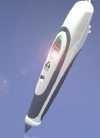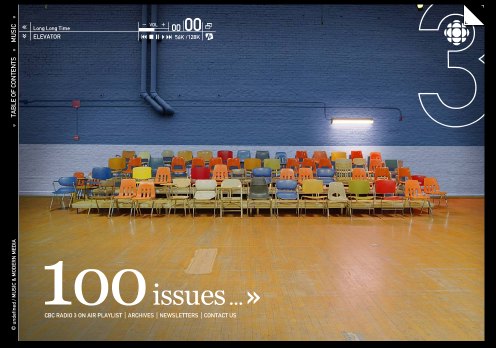The Logitech Advanced io2 Digital Writing System is a pen which stores the paths that you write and draw for downloading to the computer. It works with special paper that has a pattern of tiny dots that are tracked by a sensor under the nib. (See LogitechÆ io‚Ñ¢ Digital Writing” href=”http://www.logitech.com/index.cfm?PATH=products/features/digitalwriting&PAGE=products/features/digitalwriting&CRID=1545&REF=CRID=1545&countryid=19&languageid=1″>Logitech Products >Logitech’s Digital Writing site.
The underlying technology is called Anoto and it is also being used in products like LeapFrog’s FLY pentop computer for kids. Fly lets kids draw out a piano keyboard and then lets you play the piano by pressing the pen to the keys. A sound synthesizer plays the note.
Such pen and voice systems suggest a whole new type of interface that is not screen or touch pad based. You could have a pen shaped phone where you just write the phone number down and it calls it. The trick is the paper that lets it tack its absolute position even if you raise the pen and move it. I’m sure we are going to see innovative uses for this technology that take advantage of what you can do when you don’t need a screen.
Continue reading Digital Pens (Anoto, io2, and Fly)
What is bullshit?
Slate has a cute review on Defining Bullshit – A philosophy professor says it’s a process, not a product. By Timothy Noah (Wednesday, March 2, 2005). The review essay concludes that bullshit is a lie (or lying), but a disregard for the truth – the bullshitter doesn’t really care what is true – they just want to spout and be heard. Sounds like a lot of blogs to me.
Alias Visualization Studio
What would a high-end computer supported visualization studio look like? The Alias Visualization Studio, from the look of the web site, is a space for smaller groups to visualize design ideas (developed with Alias software no doubt) and discuss them. Unlike caves and walls that I have seen, this seems to use mostly projectors and seems to have benefited from an architect who thought of the whole space. How could we use these in education?
Thanks to Mark Chamberlain for this.
Matt Patey’s Re
Notes on text analysis and toys is a blog by a student here at Mac, Matt Patey, on a project for visualizing the neighborhood of a web site. He is combining text analysis techniques to build picture of how a page sits with others with a similar profile.
Scholarship of Teaching
The Scholarship of Teaching and Learning: An Annotated Bibliography is a useful bibliography (as of 2002) coming out a movement from the “classic” report by Boyer, Scholarship Reconsidered: Priorities of the Professoriate which identifies four types of scholarship from scholarship of discovery to scholarship of teaching. The bibliography works for me because it is annotated concisely and because they haven’t tried to include everything.
What’s also interesting is how “Scholarship of Teaching and Learning” seems to be the catchphrase for treating an investigative approach to teaching as research – if teaching can’t beat research it should join it. Of course, a scholarly approach to teaching doesn’t mean good teaching … though it probably makes a difference.
For many in higher education, the most salient history begins with Scholarship Reconsidered, the 1990 report by Ernest Boyer, writing as president of The Carnegie Foundation. Boyer contends we must “move beyond the tired old ‘teaching versus research’ debate and give the familiar and honorable term ‘scholarship’ a broader, more capacious meaning,” one that includes four distinct but interrelated dimensions: discovery, integration, application, and teaching. In thus staking a claim for the scholarship of teaching, Boyer seeks to bring greater recognition and reward to teaching, and is also suggesting that excellent teaching is marked by the same habits of mind that characterize other types of scholarly work (he does not sharply distinguish between excellent teaching and the scholarship of teaching). Scholarship Reconsidered has given powerful momentum to a wave of reports and recommendations from both campuses and scholarly societies that share this agenda of bringing greater attention and recognition to teaching.
Teaching Knowledge Posters
In an iMatter meeting we were talking about poster sessions both online and f2f for sharing information. The Visible Knowledge Project has a nice example of virtual posters about learning and technology. These posters were created with a snapshot tool based on the Knowledge Media Laboratory KEEP tool. (See What is KEEP? for an overview.) KEEP encourages instructors to gather snapshots of their teaching experiments so that they can be shared easily as virtual posters. The underlying idea is that we need practices that let us share scholarship of teaching quickly.
Continue reading Teaching Knowledge Posters
The Passing of the CBC Radio Three Web Magazine

One of the best designed web magazines, the CBCRadio3.com Magazine site has “published” its last issue. An article in the Globe and Mail by Alexandra Gill, “CBC Radio Three’s lauded Web mag dies” (March 5, 2005, Page R5) nicely points out the irony of CBC killing this award winning radio site just when others are moving in.
I know from my students that the site had the attention of the youth demographic (or at least some of them.) It was an attempt to reach youth in a way that CBC Radio 1 and 2 didn’t. It was a multimedia magazine with music, arts, and essays rather than a radio show. The site lets you listen to music (and control it) as you read the mag – a bit like having the radio you listen to and the magazine you thumb through coordinated. The interface design was brilliant and immediately intriguing, even if difficult to figure out initially.
Why CBC is killing it is not clear. Perhaps not enough people want to watch radio off the screen or perhaps they want to get out of online media and stick to radio. Podcasts will be next.
Statistics Canada Report: High-tech Growth
According to a story by Jack Kapica, “Globetechnology: Canadian high-tech sector shows signs of growth” (Globe and Mail Update, March 4, 2005), Statistics Canada is reporting that the high-tech sector is showing high rates of entry of new businesses which show that financial backers see opportunity. The high rates of entry could lead to strong employment growth. The Statistics Canada report is titled “An anatomy of growth and decline: high-tech industries through the boom and bust years, 1997-2003“. Here is the abstract:
This paper tracks the growth and decline of information and communications technology (ICT) industries that were synonymous with the so-called new economy boom of the late-1990s and its subsequent bust period in the early 2000s. The analysis focuses on the question of whether the ICT bust has been accompanied by a structural shift illustrated by less firm turnover. It shows that to date there is little evidence of a structural shift. Entry rates of new establishments within the ICT sector were above those of other sectors within the economy during both the ICT boom and bust. This is evidence that both firms and entrepreneurs continued to see opportunities to develop new products and markets even during a time of retrenchment. The location of the ICT sector also showed little evidence of a change.
Stanford d.School
The Stanford Institute of Design or d.school is “a bold new design institute at Stanford founded by the likes of Terry Winograd. It seems to have come out of “Computer Science, Mechanical Engineering, Management Science and Engineering, and the Graduate School of Business”. Strangely there don’t seem to be any architects or artists involved – it seems to be about engineering and business.
The web site is brilliant, I love the d.Manifesto – “All you need to know. On a napkin.” The section on “Our Place” also shows their ideas for an innovative project space for students and visiting faculty.
Thanks to Audrey for pointing me to this.
What is a tool?
Language is the principal – or perhaps the only – tool of the philosopher. For Wittgenstein, and for analytic philosophy in general, philosophy consists in clarifying how language can be used. The hope is that when language is used clearly, philosophical problems are found to dissolve. (Analytic philosophy – Wikipedia)
Bernie Frischer asked me what a tool is in the context of humanities computing. Setting aside a discussion of the discourse of tools and ends, here is a first pass:
- An algorithm for the transformation of data. In the case of humanities computing this would typically be for the transformation of linguistic data or strings.
- A utility program that implements an algorithm (see 1.) or simple set of processes in a form that can be used easily. Generally a tool is not a full blown interactive program like a word processor. Thus Excel I would not call a tool as you can use it interactively and you can use it to do many different things. You can, however, run transformations within it.
- A technique that involves transformative or interpretative practices some of which might be automated on the computer. Thus a technique includes both human and automatable practices. Even more generally one can talk about methods that might be made up of various techniques.
- A interactive environment or game in which one can run a set of transformations for a single purpose. See 2. above. There is obviously a grey area between an atomistic tool that does one thing (just what is the doing of “one” thing) and an environment that is multipurpose. At what point does a tool become an environment for processes that isn’t really ONE tool but more a workbench of tools. My point, however, is that we will call an environment a tool if it is used in a context for one end. Thus Excel becomes a tool if I just use it to sort columns of text.
Now back to the real problem which is the presumption that a tool is utilitarian – that is something used not for play, but for achieving a well defined goal.